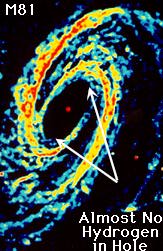The standard theory of galaxy formation states that galaxies are formed from collapsed clouds of primordial gas and dust. If this really was the case -- the Ball-of-Light Particle Model predicts it is not -- then it should be possible to see examples of these clouds of gas and dust in many predictable locations.
For example, the brightness of the light from a galaxy is directly proportional to how many stars are located in specific parts of the galaxy. The bulge of a galaxy is brighter because it has many more stars than the outer region. Thus there should be large amounts of gas and dust in the centers of galaxies. Scientists have looked at one galaxy -- M81 -- using radio telescopes to determine if the galaxy is emitting radiation from hydrogen. This galaxy showed exactly the opposite.

In the outer arms, there is hydrogen. But in the center of M81 there is almost no hydrogen! The Ball-of-Light Particle Model predicts the core of M81 is ejecting stars from its core that are essentially stable until they reach the outside of this hole where gravity slows the stars enough so the star decaying and thus making the hydrogen.
Note the hole is very elliptical. It would be a very weak argument to say that the stars in the center of the galaxy -- in this ellipse -- have consumed the hydrogen. If traditional theory is correct then the hydrogen in the arms is streaming into the center of this galaxy -- instead of streaming out as predicted by the Ball-of-Light Particle Model -- and thus there must me some very hungry stars around the outer edge of this ellipse consuming the hydrogen before it makes its way inwards any further!
Under Construction